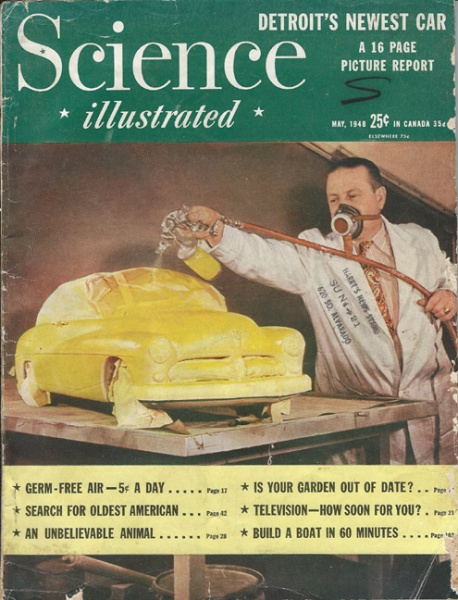The ’49 Mercury is probably one of the most recognized cars in the world. It was originally supposed to have been the new Ford according to several sources. But the body went to Merc and Ford got the new famous “shoe-box” styling.
When I was going through my old magazine collection I remembered I had an issue of Science Illustrated. No, I had never heard of that magazine before either and I must have bought it at a yard sale or something with a stack of other mags. The May 1948 issue had a very interesting article about the styling of the ’49 Mercury. Inside were photos I had never seen before and found it to be totally fascinating. I already knew how automobiles were designed and produced but to see the ’49 Merc going through this process was a rare treat. So I thought I’d share it with you here on the Hot Rod Bunny blog.

The cover is the first thing that grabs you. A very accurate plaster ¼ scale model is being painted bright yellow. There is something unusual about it that is hard to notice at this angle but you’ll see it in the other photos.

There are a few sketches that are seen in the background but can’t really be identified. The designer is working on a front ¾ angle and it already has the Merc look. The photo of the full size airbrush illustration is one I have seen before. The shots of the beginning of the clay model are pictures that I hadn’t seen before. Now look at the plaster body being pulled from the mold. Note that the car is a fastback! Many other cars offered fastback designs in ’49 but not the Mercury. If you were ever curious about what it would have looked like…there is what they were thinking! The brand survived fine without it but after seeing it you have to wonder what it would look like with a chopped roof!

After the full-size clay was made they transferred the dimensions to the pattern department to make the car out of mahogany. It wasn’t for the sheer purpose of making it out of wood. They used that tough wood pattern to hammer sheet steel into the shape of the car. The metal one-off was then assembled and tested. They need to make sure it can be put together easily and find out where the weak spots are. The one-off is usually not as good as the production version and is discarded after they’re finished with it.

Finally we see one of the first production cars being built. Note it’s a four-door sedan, the bread and butter part of the line. That shot is the beginning of the legend. I wonder how many Mercurys rolled off that assembly line and are still around in one form or another?
That’s a look at Science illustrated’s May ’48 article on styling the ’49 Mercury. Now you know what magazine to look for next time you’re at a yard sale or flea market!
